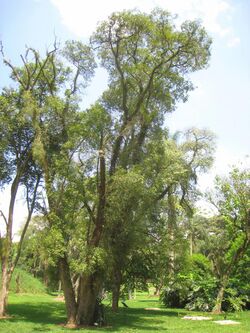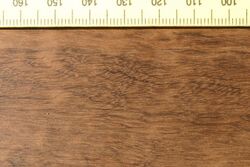Biology:Ocotea porosa
| Ocotea porosa | |
|---|---|

| |
| Scientific classification | |
| Kingdom: | Plantae |
| Clade: | Tracheophytes |
| Clade: | Angiosperms |
| Clade: | Magnoliids |
| Order: | Laurales |
| Family: | Lauraceae |
| Genus: | Ocotea |
| Species: | O. porosa
|
| Binomial name | |
| Ocotea porosa (Nees & Martius) Barroso
| |
| Synonyms[2] | |
Ocotea porosa, commonly called imbuia or Brazilian walnut, is a species of plant in the Lauraceae family. Its wood is very hard, and it is a major commercial timber species in Brazil.
Taxonomy and naming
It is often placed in the related genus, Phoebe. It is commonly called imbuia, and is also known as Brazilian walnut,[3] because its wood resembles that of some walnuts (to which it is not related).[4]
Portuguese common names (with variant spellings) include embuia, embúia, embuya, imbuia, imbúia, imbuya, canela-imbuia.[citation needed]
Habitat
The tree grows naturally in the subtropical montane Araucaria forests of southern Brazil , mostly in the states of Paraná and Santa Catarina (where it is the official state tree since 1973), and in smaller numbers in São Paulo and Rio Grande do Sul. The species may also occur in adjacent Argentina and/or Paraguay.[5]
In its native habitat it is a threatened species.[citation needed]
Description
The trees typically reach 40 m (130 ft) in height and 1.8 m (5 ft 11 in) in trunk diameter.[6]
The wood is very hard, measuring 3,684 lbf (16,390 N) on the Janka scale. The wood is also fragrant[7] with hints of nutmeg and cinnamon (also a member of the Lauraceae).[citation needed]
Uses
The tree is a major commercial timber species in Brazil, used for high-end furniture, mostly as decorative veneers, and as flooring.[4]
The tree is also a popular horticultural tree in subtropical regions of the world.[citation needed]
References
- ↑ Varty, N.; Guadagnin, D.L. (1998). "Ocotea porosa". IUCN Red List of Threatened Species 1998: e.T32978A9739985. doi:10.2305/IUCN.UK.1998.RLTS.T32978A9739985.en. https://www.iucnredlist.org/species/32978/9739985. Retrieved 16 November 2021.
- ↑ "Ocotea porosa (Nees & Mart.) Barroso — The Plant List". http://www.theplantlist.org/tpl/record/kew-2386884.
- ↑ Juliana R. Cordeiro et al. (2012). "Identification of Four Wood Species by an Electronic Nose and by LIBS". International Journal of Electrochemistry 2012: 1–5. doi:10.1155/2012/563939. Article ID 563939.
- ↑ 4.0 4.1 "Phoebe porosa". Center for Wood Anatomy Research. http://www2.fpl.fs.fed.us/TechSheets/Chudnoff/TropAmerican/pdf_files/phoebe1new.pdf.
- ↑ Documentação, Divisão de. "LEI Nº 4.984, de 30 de novembro de 1973". http://leis.alesc.sc.gov.br/html/1973/4984_1973_Lei.html.
- ↑ Terry Porter: "Wood Identification and Use", page 167. Guild of Master Craftsman Publications Ltd. 2004
- ↑ Eric Meier, ed (2013). "The Wood Database". http://www.wood-database.com/lumber-identification/hardwoods/imbuia/.
Wikidata ☰ Q1935528 entry
 |



